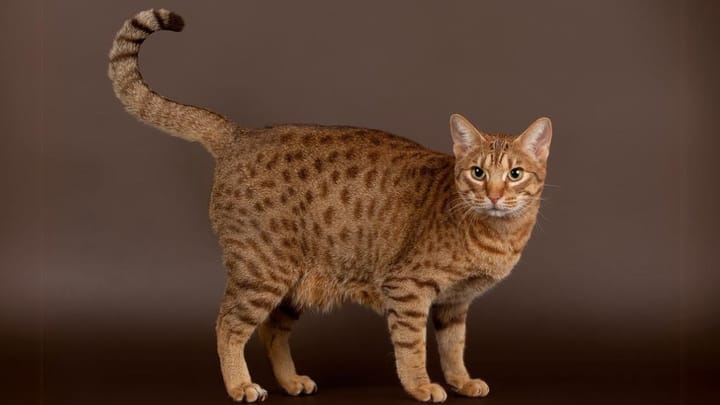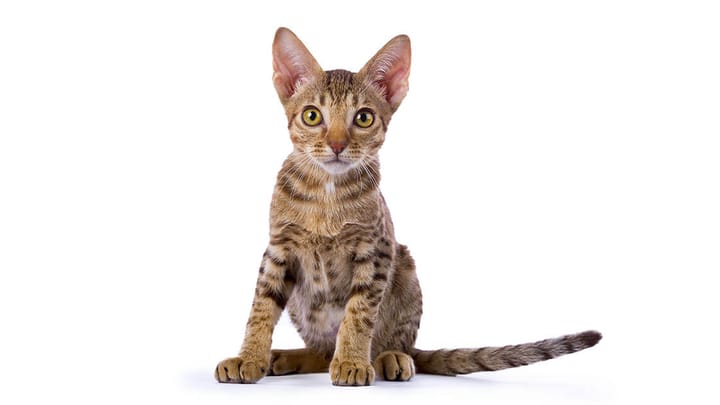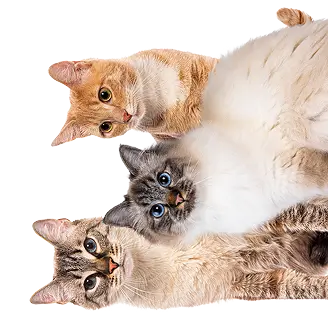Ocicat


This breed owes its name to a large wild cat called the Ocelot, despite the fact that it has never been crossed with one. It is only because of the resemblance with the coat of the Ocelot that the breeder gave it this name. Beyond their elegance, Ocicats are great pets to live with, which will adapt to any indoor environment that suits their needs.
|
Life expectancy |
The Ocicat has a life expectancy of between 12 and 15 years |
|
Temperament |
|
|
Adult size |
Female
Approximately 12 in
Male
Approximately 12 in
|
|
Adult weight |
Female
Between 7 and 11 lb
Male
Between 9 and 13 lb
|
|
Coat colour
Black, chocolate, lilac, cinnamon, fawn, blue Each colour will have spots that are darker than the rest of the coat. |
Black Brown Cream Blue |
|
Type of coat
Short |
Short |
|
Eye colour
Green, golden yellow |
Green
Yellow
Brown
|
|
Purchase price |
The Ocicat costs approximately 250£ |
This breed cannot have white spots or specks.
More details about the Ocicat
Ocicat: Origins and history
This breed is native to the United States. A farmer had the desire to create a Siamese tabby point. She crossed a Siamese / Abyssinian cat with a Siamese chocolate point cat. In the litter, only one of the kittens presented an atypical coat, ivory with small golden patches. Although this kitten was castrated, breeding of this breed continued. Other breeders made crosses with Abyssinians and Siamese but also with other breeds like the American Shorthair. Thus, different colours of coats appeared with the arrival of the modern Ocicat, which was recognised by the TICA in 1986. It was only three years later that it appeared in Europe where it remains rather rare, unlike in the USA.
Physical characteristics of the Ocicat
These domestic cats are not just elegant, they have long and athletic bodies thanks to their strong muscle and bone structure. Their spots give them the appearance of a wild cat. Their beautiful almond eyes are surrounded by coloured bands on their heads that look like mascara. The same coloured bands appear on their legs.
Ocicat: Characteristics
Ocicat: Behaviour
Breed compatibility Ocicat
Ocicat: Purchase price
On average, the price of an Ocicat kitten is approximately £250. The price varies according to the lineage of the kitten, the breeder, the age at the time of its acquisition or even the sex. It will cost on average £35/month to meet the needs of an Ocicat, to purchase good quality food etc.
Ocicat: Shedding
Average
When moulting you will need to brush your cat weekly.
Ocicat: Grooming
Regular brushing will suffice to meet the needs of this easy to look after cat.
Ocicat: Health
Ocicats live for between 12 and 15 years.
Their short hair means they are less resistant to the cold than they are to heat.
Unless they have something to keep them busy, Ocicats risk getting bored and taking an interest in eating. It is important to regularly check that your cat is not putting on too much weight which could lead to health problems.
The Ocicat can develop the same illnesses as any other cat, such as oral diseases.
Some diseases are specific to this breed:
- Progressive atrophy of the retina is a disease that can cause blindness in this breed. A screening test does exist.
- Hypertrophic cardiomyopathy results in thickening of the heart muscle.This causes heart failure that can result in arrhythmias, or pulmonary edema. Screening is done by means of an echocardiography examination, which is usually renewed annually. A treatment can be administered to reduce discomfort.
Ocicats usually have litters of around 4 kittens.
They can only be bred with other Ocicats, mating with Abyssinians has been banned.






